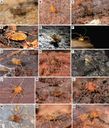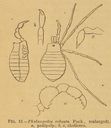Armoured harvestmen
Laniatores
Classification
- Phylum: Arthropoda
- Subphylum: Chelicerata
- Class: Arachnida
- Order: Opiliones
- Suborder: Laniatores
Pronunciation
How to pronounce Laniatores: //læˈniəˌtɔriːz//
These audio files are automatically generated. While they are not always 100% accurate, they are a good starting point.
Images






Summary
Laniatores is a diverse suborder of harvestmen known for their spiny pedipalps and reliance on humid, forested ecosystems. They include over 4,200 described species and exhibit a variety of reproductive behaviors and adaptations to their environments.
Physical Characteristics
Members of Laniatores have captures spines on all or most segments of the pedipalps, usually robust with strong spines. The dorsal scutum consists of a single piece, with the carapace or peltidium entirely fused with abdominal scutum. Most species have comparatively short legs, typically not much longer than the body.
Identification Tips
Look for a robust pedipalpus armed with strong spines, a short and unsegmented ovipositor, and a complex penis structure with many sclerites, some of which are movable.
Habitat
Forested habitats, including under rocks and logs, in leaf litter, and caves. They typically prefer humid environments, correlating with tropical and temperate forests.
Distribution
Widespread globally; centers of diversity include the western US and southern Appalachians. Various infraorders and superfamilies show specific geographic preferences, with Travunioidea typical of northern temperate regions and Triaenonychoidea in southern temperate regions.
Diet
Reclusive predators, typically feeding on small arthropods found in their habitats.
Life Cycle
Reproduce sexually through direct insemination. Females utilize an ovipositor to lay eggs.
Reproduction
Females lay eggs using an ovipositor; some Neotropical members exhibit postzygotic paternal care.
Ecosystem Role
Important predators in their ecosystems, helping control populations of other small invertebrates.
Collecting Methods
- Searching under rocks and logs
- Sifting leaf litter
- Using a Berlese funnel
Evolution
Laniatores is the largest suborder of Opiliones, with ongoing debates on the definitions and limits of its superfamilies. Major evolutionary developments include the adaptations to humid environments and unique reproductive behaviors.
Tags
- Arachnida
- Opiliones
- Laniatores
- Harvestmen
- Biodiversity